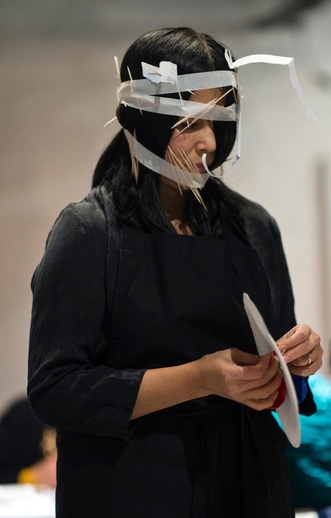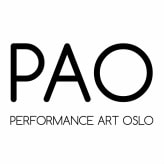Interview with Pavana Reid

31 August 2016, Bangor, Co.Down Northern Ireland, UK
Q: Why / when / how did you start to work with performance, what is your background, how did you arrive at doing performance?
I started “doing” performance before I knew about performance art. Through photography, I captured images of myself as a study or self portrait. First it was about expressing, searching and capturing unpolished images. The kind that happen suddenly and unplanned. So that way of doing and capturing were as if I were both the artist and the audience at the same time. Later at University I learnt more about performance art and then I started to ask; what is performance art? When and how does an action become performance art?
I tried to find the answer by doing more actions in random spaces. I also attended workshops run by performance artists, started making my own performances and began a gentle intervention with other artists through the workshops. I later joined Bbeyond, a Performance art organisation based in Belfast.
Q: What is your process like when you make a performance, from idea to actual work?
When an idea about a performance comes up, I let the idea circle around in my head. I collect all my thoughts, then piece them together and then I repeat them to myself by writing a short note or creating a little drawing to help me remember it. I have many ideas written down in my sketchbook and short notes on many pieces of paper- often they are just words or one sentence. Ideas pop up everywhere perhaps when I am about to go to sleep or while I’m cooking in my kitchen or sitting on a plane. When I am organising a performance for an event or a project, some of these little ideas might come up again and start to grow into an imaginary performance. Sometimes nothing grows and I just stay with one strong idea and then maybe during the performance one of these ideas might come into my mind and I will improvise the idea into an action which interacts with the audience and the space. I love a simple idea which has room to grow during the performance. For example, I might ask the audience to sit with me or I might give a fortune cookie to people before they enter a prison.
Q: Can you tell about your latest project?
I am working on three projects which I’ve initiated and organised with different groups of artists. The first project is a performance art exchange project between Thailand and Norway which will happen in December this year. The theme of the project is “ It’s Personal”. The second project is a collaboration with an artist from Northern Ireland, Elaine McGinn. Our concept is about the sharing of all things in life and existence. The theme is “what mines is yours what yours is mines”. My third project is about time, but I don’t want to say more until it happens.
Q: What role does performance art have in your life / artistic praxis? Do you also work within other fields, like installation, sculpture, drawing, and other expressions? How do they influence / inform each other?
Performance art is an important part of our lives because both my husband and I are performance artists. We normally work separately, but we talk about art and are surrounded by it in our everyday life. We count ourselves lucky because performance art is not an easy subject for many people to endure.
I am also working on performance related to photography; still and moving pictures and documenting performances. With these experiences, I can see the difference between live art and performance art as the artist and audience share an experience in the same time and place. Whereas a single image or moving picture (video work) has been processed, seen and selected by another person before the audience as a consumer can experience it.

Q: With what kind of form / material do you express yourself and use in your work and how did you arrive at using this material?
I mostly use materials which I associate with different periods of my life such as household objects, food and clothes which represent my identity as a traveller, stranger and foreigner. With concepts such as space, time, thought and belief- which are more abstract, I like to experiment with different objects which have a unique quality for example an incense stick, kitchen timer or apron. I sometimes use technology or equipment as a part of my performance. In this kind of performance, I feel free and playful as I am not relying on personal history, feelings or emotions. I collaborated with Henrik Koppen in a performance “ Weather Conversation”. I interacted with him though light and sound which he created live and it was projected on a screen.
Q: How do you experience or consider the audience / surrounding? What space / surrounding do you find interesting to work in? How does your surrounding influence your work? Do you involve the public? If so, how?
I like experimenting with materials, forms, space and ideas. I have no problems doing a performance in any kind of space. When I start a performance, I slowly find my movement and pace in the space and often it takes time to build itself up, a kind of slow performance. For example, I pasted pages of newspapers together, one by one to create movement, shape and form. Building up material for me is like building up a story before you unfold it at the end.
I sometimes initiate directions and situations with the audience in my performances and I also give the audience the freedom to interact with me which will influence the direction of the performance. I am consciously thinking about mental space ( an ideology); feeling fear, trust, belief and faith etc. The movement of the unseen in our mind. I recognise time and the space of time and I am working on a project which collects actions in actual time and space.
<< Back
I mostly use materials which I associate with different periods of my life such as household objects, food and clothes which represent my identity as a traveller, stranger and foreigner. With concepts such as space, time, thought and belief- which are more abstract, I like to experiment with different objects which have a unique quality for example an incense stick, kitchen timer or apron. I sometimes use technology or equipment as a part of my performance. In this kind of performance, I feel free and playful as I am not relying on personal history, feelings or emotions. I collaborated with Henrik Koppen in a performance “ Weather Conversation”. I interacted with him though light and sound which he created live and it was projected on a screen.
Q: How do you experience or consider the audience / surrounding? What space / surrounding do you find interesting to work in? How does your surrounding influence your work? Do you involve the public? If so, how?
I like experimenting with materials, forms, space and ideas. I have no problems doing a performance in any kind of space. When I start a performance, I slowly find my movement and pace in the space and often it takes time to build itself up, a kind of slow performance. For example, I pasted pages of newspapers together, one by one to create movement, shape and form. Building up material for me is like building up a story before you unfold it at the end.
I sometimes initiate directions and situations with the audience in my performances and I also give the audience the freedom to interact with me which will influence the direction of the performance. I am consciously thinking about mental space ( an ideology); feeling fear, trust, belief and faith etc. The movement of the unseen in our mind. I recognise time and the space of time and I am working on a project which collects actions in actual time and space.
<< Back
